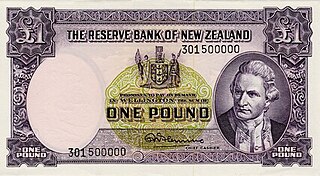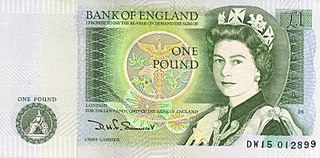Related Research Articles

The Bank of England is the central bank of the United Kingdom and the model on which most modern central banks have been based. Established in 1694 to act as the English Government's banker and debt manager, and still one of the bankers for the government of the United Kingdom, it is the world's second oldest central bank.

A banknote or bank note – also called a bill or simply a note – is a type of paper money that is made and distributed ("issued") by a bank of issue, payable to the bearer on demand. Banknotes were originally issued by commercial banks, which were legally required to redeem the notes for legal tender when presented to the chief cashier of the originating bank. These commercial banknotes only traded at face value in the market served by the issuing bank. Commercial banknotes have primarily been replaced by national banknotes issued by central banks or monetary authorities.
The Reserve Bank of New Zealand (RBNZ) is the central bank of New Zealand. It was established in 1934 and is currently constituted under the Reserve Bank of New Zealand Act 2021. The governor of the Reserve Bank, currently Adrian Orr, is responsible for New Zealand's currency and operating monetary policy.

The pound was the currency of New Zealand from 1933 until 1967, when it was replaced by the New Zealand dollar. Prior to this, New Zealand used the pound sterling since the Treaty of Waitangi in 1840. Like the pound sterling, it was subdivided into 20 shillings each of 12 pence.

The Bank of England, which is now the central bank of the United Kingdom, British Crown Dependencies and British Overseas Territories, has issued banknotes since 1694. In 1921 the Bank of England gained a legal monopoly on the issue of banknotes in England and Wales, a process that started with the Bank Charter Act 1844, when the ability of other banks to issue notes was restricted.

The banknotes of Zimbabwe were physical forms of Zimbabwe's first four incarnations of the dollar, from 1980 to 2009. The banknotes of the first dollar replaced those of the Rhodesian dollar at par in 1981, one year after the proclamation of independence. The Reserve Bank of Zimbabwe issued most of the banknotes and other types of currency notes in its history, including the bearer cheques and special agro-cheques that circulated between 15 September 2003 and 31 December 2008: the Standard Chartered Bank also issued their own emergency cheques from 2003 to 2004.
New Zealand dollar banknotes are the banknotes in circulation in New Zealand, the Cook Islands, Tokelau, Niue and the Pitcairn Islands, denominated in the New Zealand dollar. They are issued by the Reserve Bank of New Zealand and since 1999 have been made of polymer.
Leslie Edward Pithie was a New Zealand rower who won a bronze medal for his country at the 1938 British Empire Games.

The Chief Cashier of the Bank of England is the person responsible for issuing banknotes at the Bank of England and is the director of the divisions which provide the Bank of England's banking infrastructure. This person is known to the general public because since 1870 the Chief Cashier's signature is printed on all bank notes issued by the Bank of England. In 2004 a new post was created, Executive Director of Banking & Chief Cashier, incorporating the title.
Victoria Mary Florence Cleland is a British banker. She was the Director for Banknotes and Chief Cashier of the Bank of England, a position she held from March 2014 until 1 June 2018 when was replaced by Sarah John. She is the second woman to hold the post of Chief Cashier. She replaced Chris Salmon when he was appointed as Executive Director for Markets at the Bank of England. As of 2024 she is currently the Executive Director for Payments for the Bank of England
Chris Salmon was Executive Director, Markets at the Bank of England. Between 2011 and 2014 he was Chief Cashier of the Bank of England. The signature of the Chief Cashier appears on British banknotes. Salmon was succeeded as Chief Cashier by Victoria Cleland.
Graham Edward Alfred Kentfield was Chief Cashier of the Bank of England from 1991 to 1998. The signature of the Chief Cashier appears on British banknotes. Kentfield was replaced as Chief Cashier by Merlyn Lowther.
George Malcolm Gill was Chief Cashier of the Bank of England from 1988 to 1991. The signature of the Chief Cashier appears on British banknotes. Gill was replaced as Chief Cashier by Graham Kentfield. He was one of the shortest serving Chief Cashiers and during Gill's tenancy, two different £5 notes were issued with his signature.

Matthew Marshall (1791–1873) was the Chief Cashier of the Bank of England from 1835 to 1864.

The Bank of England £10 note, also known informally as a tenner, is a sterling banknote. It is the second-lowest denomination of banknote issued by the Bank of England. The current polymer notes, first issued on 5 June 2024, bears the images of King Charles III and the late Queen Elizabeth II first issued on 14 September 2017 on the obverse, and the image of author Jane Austen on the reverse. The final cotton paper note featuring a portrait of naturalist Charles Darwin, first issued in 2000, was withdrawn from circulation on 1 March 2018.

The Bank of England £20 note is a sterling banknote. It is the second-highest denomination of banknote currently issued by the Bank of England. The current polymer notes, first issued on 5 June 2024, bears the image of King Charles III on the obverse. The other note first issued on 20 February 2020, bears the image of the late Queen Elizabeth II on the obverse and the image of painter J. M. W. Turner on the reverse. It replaced the cotton paper note featuring a portrait of economist Adam Smith, first issued in 2007.

The Bank of England £50 note is a sterling banknote circulated in the United Kingdom. It is the highest denomination of banknote currently issued for public circulation by the Bank of England. The current note, the second of this denomination to be printed in polymer, entered circulation on 5 June 2024. It bears the images of King Charles III on the obverse and computer scientist and World War II codebreaker Alan Turing on the reverse, with his birth date reflecting the release date. Cotton £50 notes from the previous series remained in circulation alongside the new polymer notes until 30 September 2022, when the last 'paper' banknote issue finally ceased to be legal tender.

The Bank of England £1 note was a sterling banknote. After the ten shilling note was withdrawn in 1970, it became the smallest denomination note issued by the Bank of England. The one pound note was issued by the Bank of England for the first time in 1797 and continued to be printed until 1984. The note was withdrawn in 1988 due to inflation and was replaced by a coin.
The Bank of England £100,000,000 note, also referred to as Titan, is a non-circulating Bank of England sterling banknote used to back the value of Scottish and Northern Irish banknotes. It is the highest denomination of banknote printed by the Bank of England. As both Scotland and Northern Ireland have banknotes issued by particular local banks, the non-circulating notes provide the essential link between those banknotes and that of England and Wales, and security if a local issuing bank were to fail.

Gilbert Wilson was best known for being the governor of the Reserve Bank of New Zealand.
References
- ↑ "Birth, Death and Marriage Historical Records". Births, Deaths & Marriages Online. Retrieved 31 January 2025.
- 1 2 3 4 5 "Banknote signatures". Reserve Bank of New Zealand. Retrieved 31 January 2025.
- 1 2 3 "Reserve bank Executive Appointments". No. 21735. Evening Star. 1 June 1934. p. 12. Retrieved 31 January 2025.
- 1 2 "New Bank-Notes The Change in Signature". 60. No. 101. Ashburton Guardian. 8 February 1940. p. 2. Retrieved 31 January 2025.
- ↑ "Chief Cashiers". Bank of England. Retrieved 3 February 2025.
- ↑ "Personal Items". No. 54. Hawera Star. 16 June 1934. p. 4.
- ↑ "Reserve Bank Three New Directors Appointed". LXXXIX. No. 27015. Stuff. 15 April 1953. p. 8. Retrieved 31 January 2025.